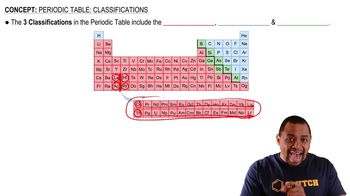Here are the essential concepts you must grasp in order to answer the question correctly.
Electron Configuration
Electron configuration describes the distribution of electrons in an atom's orbitals. It follows the Aufbau principle, which states that electrons fill the lowest energy orbitals first, and is represented using a notation that indicates the energy levels and sublevels occupied by electrons, such as 1s² 2s² 2p⁶.
Recommended video:
Electron Configuration Example
Periodic Table and Atomic Structure
The periodic table organizes elements based on their atomic number and electron configuration. Understanding an element's position in the table helps predict its electron configuration, as elements in the same group often have similar configurations, particularly in their outermost shells.
Recommended video:
Periodic Table Classifications
Valence Electrons
Valence electrons are the electrons in the outermost shell of an atom and are crucial for determining an element's chemical properties and reactivity. The number of valence electrons influences how an element bonds with others, making it essential to consider when writing electron configurations.
Recommended video:
Transition Metals Valence Electrons
 Verified step by step guidance
Verified step by step guidance


